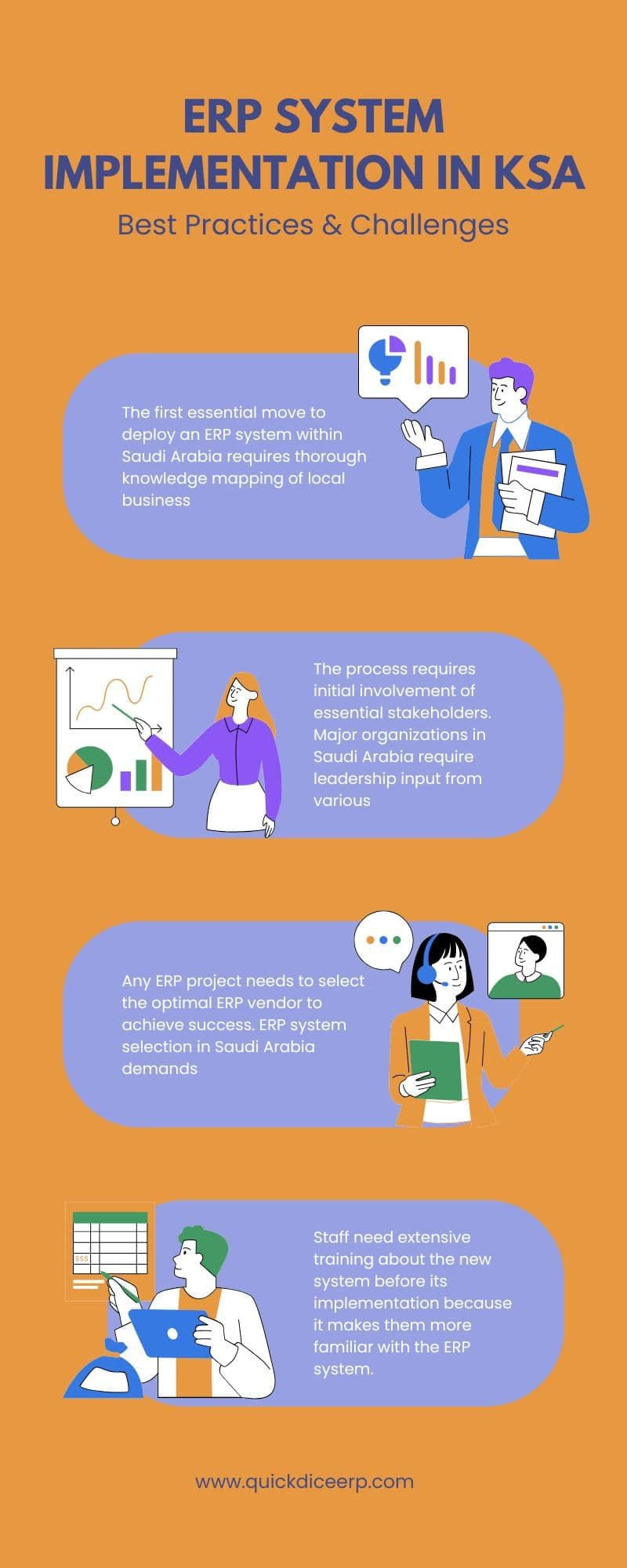


Explore key best practices and challenges of ERP system implementation in Saudi Arabia to streamline operations and boost business efficiency.
Businesses around the world use Enterprise Resource Planning (ERP) systems in the current digital environment to achieve operational optimisation while streamlining procedures and improving decision-making capabilities. The Kingdom of Saudi Arabia (KSA) strengthens its role as a regional economic center, while the ERP system in Saudi Arabia gains importance for firms seeking to stay competitive. The deployment of ERP systems enables Saudi enterprises to access real-time data and improve supply chain management, resulting in both operational improvement and significant cost savings.
When firms in Saudi Arabia want to implement an ERP system, they face a number of challenges. The path to ERP system deployment success requires strategic planning, good leadership, and the ability to overcome various barriers. Firms must plan for a variety of challenges when implementing ERP systems since they must adapt systems to local demands, adhere to regulatory standards, and integrate solutions. This article covers the most effective approaches for adopting ERP systems across the Kingdom, as well as the common problems that enterprises face while implementing transformative technologies.


The first step in deploying an ERP system in Saudi Arabia is to thoroughly map local business factors, sector-specific needs, cultural traits, and legislative directives. Saudi Arabia operates under various legal procedures, particularly in terms of taxation, employment restrictions, and compliance standards. A solution tailored to local company requirements will result in long-term cost and time benefits for enterprises.

The procedure involves the first involvement of key stakeholders. Major organizations in Saudi Arabia demand leadership input at all levels during the decision-making process. Businesses gain better implementation outcomes by involving all departments from IT to operations from the start, as this approach promotes open communication and encourages stakeholder participation.

To be successful, any ERP project must first select the best ERP vendor. ERP system selection in Saudi Arabia necessitates the employment of a vendor who exhibits a thorough understanding of Saudi Arabian markets. Organizations should choose ERP vendors who offer support services, customization solutions, and expertise of Saudi Arabian business requirements.
Staff require thorough training on the new system prior to its adoption because it increases their familiarity with the ERP system. Saudi Arabian enterprises frequently fail to emphasize employee training, resulting in unsatisfactory system utilization among employees. The success of an ERP solution is dependent on setting aside cash for both initial and ongoing training.
Organizations in Saudi Arabia and many other sectors face resistance to change, particularly when implementing new technical systems. Employees who have previously used traditional techniques may encounter difficulties when attempting to use the new ERP system. Effective change management and communication, as well as evidence that the ERP system simplifies work duties, are required for successful deployment.
Implementing ERP systems becomes more difficult when Saudi Arabian enterprises maintain their own unique business requirements and organizational processes. Creating Saudi Arabia-specific ERP solutions necessitates a significant investment of time and money. Implementing customized parts has advantages, but it also causes project delays and increases costs unless organizations handle this process effectively.
Many Saudi enterprises now use outdated information technology systems that have limited interoperability with future ERP system deployments. Data communication between systems becomes less efficient as integration fails, resulting in mistakes. The success of business operations is dependent on ensuring that the ERP system integrates with existing technologies and minimizes system downtime.
When it comes to implementing ERP systems, businesses in Saudi Arabia may expect to incur significant financial charges. A corporation must pay significant upfront expenditures for system installation and purchase, as well as ongoing expenses for system maintenance and training support. To ensure project success, organizations must effectively allocate cash and resources.
ERP system deployment in Saudi Arabia can help firms upgrade processes and acquire market leadership. Organizations that follow best practices, such as stakeholder participation from the outset, vendor selection, and trained staff implementation, will have an easier ERP deployment. To maximize the return on investment in ERP systems, organizations must meet both local regulatory requirements and overcome internal reluctance to change.
